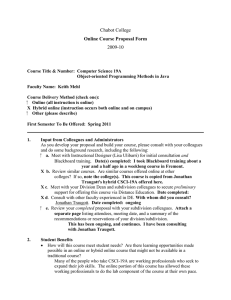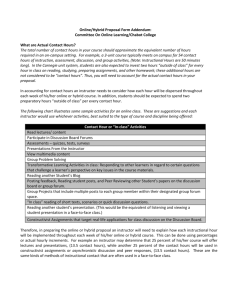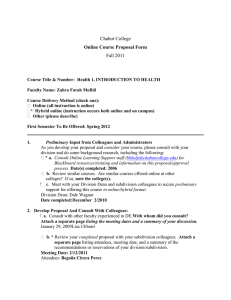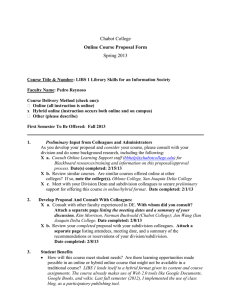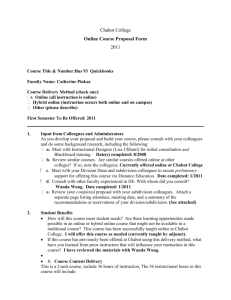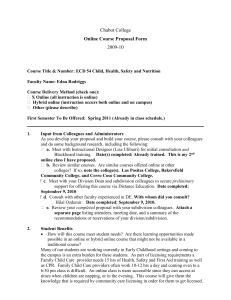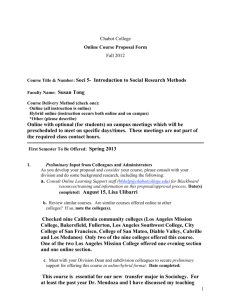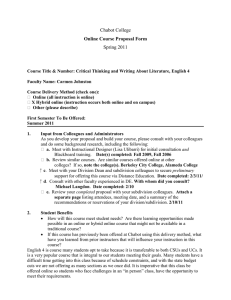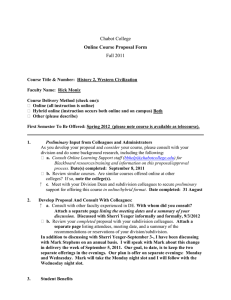NURS 73 - Chabot College
advertisement
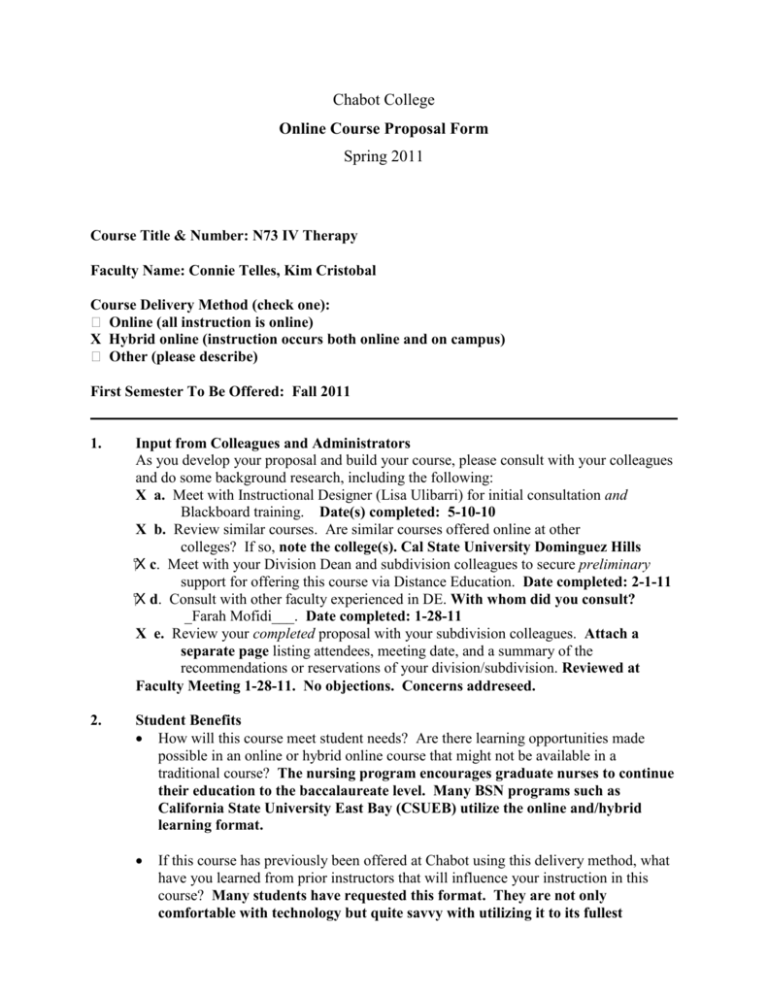
Chabot College Online Course Proposal Form Spring 2011 Course Title & Number: N73 IV Therapy Faculty Name: Connie Telles, Kim Cristobal Course Delivery Method (check one): Online (all instruction is online) X Hybrid online (instruction occurs both online and on campus) Other (please describe) First Semester To Be Offered: Fall 2011 1. Input from Colleagues and Administrators As you develop your proposal and build your course, please consult with your colleagues and do some background research, including the following: X a. Meet with Instructional Designer (Lisa Ulibarri) for initial consultation and Blackboard training. Date(s) completed: 5-10-10 X b. Review similar courses. Are similar courses offered online at other colleges? If so, note the college(s). Cal State University Dominguez Hills X c. Meet with your Division Dean and subdivision colleagues to secure preliminary support for offering this course via Distance Education. Date completed: 2-1-11 X d. Consult with other faculty experienced in DE. With whom did you consult? _Farah Mofidi___. Date completed: 1-28-11 X e. Review your completed proposal with your subdivision colleagues. Attach a separate page listing attendees, meeting date, and a summary of the recommendations or reservations of your division/subdivision. Reviewed at Faculty Meeting 1-28-11. No objections. Concerns addreseed. 2. Student Benefits How will this course meet student needs? Are there learning opportunities made possible in an online or hybrid online course that might not be available in a traditional course? The nursing program encourages graduate nurses to continue their education to the baccalaureate level. Many BSN programs such as California State University East Bay (CSUEB) utilize the online and/hybrid learning format. If this course has previously been offered at Chabot using this delivery method, what have you learned from prior instructors that will influence your instruction in this course? Many students have requested this format. They are not only comfortable with technology but quite savvy with utilizing it to its fullest potential. As an instructor I have received numerous course substitution forms from students who took online courses at other colleges. 3. Course Content Delivery The total number of contact hours in your course should approximate the equivalent number of hours required in an on-campus setting. For example, a 3-unit course typically meets on campus for 54 contact hours of instruction, assessment, discussion, and group activities. In the Carnegie unit system, students are also expected to invest two hours “outside of class” for every hour in class on reading, studying, preparing assignments, and other homework; these additional hours are not considered to be “contact hours”. Account for the contact hours in your proposal. (PLEASE NOTE: For a more detailed explanation of “contact hours” be sure to see the Addendum attached to this form.) On campus: 8 weeks x 1 ½ hrs lab = 12 hrs (50% class time) Online: Case Studies (3) Discussion board posting Cath-Sim Midterm/Final Exams Viewing multimedia sites 4. = 3 hrs = 4 hrs = 2 hrs = 1 hr = 2 hrs 12 hrs (50% class time) What percentage of the course will be on-campus, if any? What percentage of the course will consist of online lecture, video, podcasts, email, supplemental websites, CD-ROM, etc.? Lab portion will be face-to face or “live” (50%), other 50% will be online. Will any portion of your course be synchronous, requiring students to be online at the same time? If so, describe those activities, and how you will provide flexibility for students who may be unable to participate at any given time. None other than the in classroom content. Nature and Frequency of Instructor-Student Interactions How and how frequently will you interact with your students? This should include interactions with the entire class, providing feedback on assignments, and interventions when students are at-risk of dropping or failing due to poor performance or participation. I will interact both in class and online. Regular office hours will be held. I respond to e-mail within 24-48hrs and am available for individual appointments. For each type of interaction, describe why you believe it will be effective for this particular course. As a hybrid course the students have the opportunity and the freedom of a combined format. They will be responsible for their independent learning (online portion), while still having the opportunity to interact with the instructor in the classroom (lab portion). 5. Nature and Frequency of Student-Student Interactions Describe opportunities in your course for student to student interaction. This may include discussions, group projects, peer review of assignments, and other approaches. Consider how students interact in this course when taught on campus; how can you build this type of learning community online? Most of the course is a traditional live classroom-based class. There will also be discussion board questions where students can post their responses and interact with each in an asynchronous manner as well. 6. Assessment of Student Learning How will you assess learning in this course? Given the nature of online courses, how does your assessment plan ensure a level of academic integrity with which you’re comfortable? The nursing program has a zero tolerance for cheating. It may result in dismissal from the nursing program. Learning is assessed via case studies, proctored exams on BB, a research paper and discussion questions on BB. Describe how your assessment plan is consistent with your stated goals in the student benefits and student-student interactions sections of your proposal. How will you provide feedback to students? Since students have different learning styles, a variety of learning assessment methods need to be utilized. Feedback regarding written assignments will be provided within 7 working days. Exams on BB yield immediate results including the score and correct answer to further enhance learning. 7. Technology Describe any special software or multimedia tools you plan to utilize in your course (Articulate, Camtasia, Captivate, Flash, podcasts, videocasts, etc.). This is helpful to determine technology support needs. Lectures will be posted in BB using MS Word and PPT format. 8. Accommodations for Students with Disabilities Is any required video close-captioned? Is any required audio accompanied by a transcript? If you plan to use any multimedia (video, podcasts, specialized software), is that accessible to your students in terms of both software availability at home and on campus and accessible for students with disabilities? Have you provided alt-tags for your key images used in your course? Please meet with the DSRC if you need help in ensuring accessibility for your students. Students with documented disabilities will be provided a paper/pencil version of exams and afforded any additional time as outlined by the DSRC. Close captioning is not used. 9. Submit your proposal (electronic version via email and hard copy via campus mail) to the chair of the Committee on Online Learning. Faculty signature: _______________________________ Date: _______________ Division Dean signature: __________________________ Date: ________________ Online/Hybrid Proposal Form Addendum: Committee On Online Learning/Chabot College What are Actual Contact Hours? The total number of contact hours in your course should approximate the equivalent number of hours required in an on-campus setting. For example, a 3-unit course typically meets on campus for 54 contact hours of instruction, assessment, discussion, and group activities, (Note: Instructional Hours are 50 minutes long). In the Carnegie unit system, students are also expected to invest two hours “outside of class” for every hour in class on reading, studying, preparing assignments, and other homework; these additional hours are not considered to be “contact hours”. Thus, you will need to account for the actual contact hours in your proposal. In accounting for contact hours an instructor needs to consider how each hour will be dispersed throughout each week of his/her online or hybrid course. In addition, students should be expected to spend two preparatory hours “outside of class” per every contact hour. The following chart illustrates some sample activities for an online class. These are suggestions and each instructor would use whichever activities, best suited to the type of course and discipline being offered: Contact Hour or “In-class” Activities Read lectures/ content Participate in Discussion Board Forums Assessments – quizzes, tests, surveys Presentations From the Instructor View multimedia content Group Problem Solving Transformative Learning Activities in class: Responding to other learners in regard to certain questions that challenge a learner’s perspective on key issues in the course materials. Reading another Student’s Blog Posting feedback, Reading student posts, and Peer Reviewing other Student’s papers on the discussion board or group forum. Group Projects that include multiple posts to each group member within their designated group forum space. “In class” reading of short texts, scenarios or quick discussion questions. Reading another student’s presentation. (This would be the equivalent of listening and viewing a student presentation in a face-to-face class.) Constructivist Assignments that target real-life applications for class discussion on the Discussion Board. Therefore, in preparing the online or hybrid proposal an instructor will need to explain how each instructional hour will be implemented throughout each week of his/her online or hybrid course. This can be done using percentages or actual hourly increments. For example an instructor may determine that 25 percent of his/her course will offer lectures and presentations, (13.5 contact hours), while another 25 percent of the contact hours will be used in constructivist assignments or asynchronistic discussion and peer responses, (13.5 contact hours). These are the same kinds of methods of instructional contact that are often used in a face-to-face class. However, there are certain learning activities that may not meet the criteria of actual “contact hours”. This chart reflects instructional, preparatory “outside of class” activities that in some cases would not necessarily be considered actual contact hours. Preparatory or “Outside of Class” Activities Read Textbooks Research Preparing assignments Viewing an internet site for one’s own research purposes. Individual Reflective Writing Journaling Writing /Composing a Blog Analyzing another student’s ideas individually. Using a WIKI for posting ideas to other class members in preparation for a Group Project. Outside reading of additional texts pertaining to the course subject matter as homework preparation. Preparing an individual class presentation. Reviewing class notes. In summary, “contact hours” are usually those segments of instructional time where the student is actively engaged in learning activities and would reflect the same type of instruction implemented in a traditional face-to-face classroom. Therefore, instructors are encouraged to offer a clear breakdown of “contact hours” in the section of the proposal entitled, “Course Content Delivery”.

